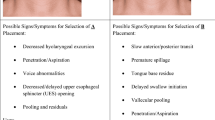Abstract
This article describes a retrospective analysis of functional outcome, time in therapy, and cost per unit of functional change in patients who received therapy for pharyngeal dysphagia. Twenty-five patients presenting dysphagia following stroke and 20 patients with dysphagia following treatment for head/neck cancer completed a systematic therapy program supplemented with surface electromyographic (sEMG) biofeedback. Eighty-seven percent (39/45) of all patients increased their functional oral intake of food/liquid including 92% of stroke patients and 80% of head/neck cancer patients. Patients with dysphagia following stroke demonstrated greater improvement than those in the head/neck cancer group. Patients in the stroke group completed more therapy sessions thus increasing the total cost of therapy, but they made more functional progress resulting in lower costs per unit of functional change than patients in the head/neck cancer group. Limitations of this study are described in reference to implications for future clinical research on the efficacy of this therapy approach.
Similar content being viewed by others
References
SE Langmore RM Miller (1994) ArticleTitleBehavioral treatment for adults with oropharyngeal dysphagia Arch Phys Med Rehabil 75 1154–1160 Occurrence Handle10.1016/0003-9993(94)90094-9 Occurrence Handle1:STN:280:ByqD3s7mt1I%3D Occurrence Handle7944924
JA Logemann PJ Kahrilas (1990) ArticleTitleRelearning to swallow after stroke—application of maneuvers and indirect biofeedback: A case study Neurology 40 1136–1139 Occurrence Handle1:STN:280:By%2BB1cjjvVM%3D Occurrence Handle2356016
S Neumann (1993) ArticleTitleSwallowing therapy with neurologic patients: Results of direct and indirect therapy methods in 66 patients suffering from neurologic disorders Dysphagia 8 150–153 Occurrence Handle1:STN:280:ByyB38zltV0%3D Occurrence Handle8467723
JA Logemann PJ Kahrilas M Kobara NB Vakil (1989) ArticleTitleThe benefit of head rotation on pharyngoesophageal dysphagia Arch Phys Med Rehabil 70 768–771
TK Shanahan JA Logemann AW Rademaker BR Pauloski PJ Kahrilas (1993) ArticleTitleChin-down posture effect on aspiration in dysphagic patients Arch Phys Med Rehabil 74 736–739 Occurrence Handle10.1016/0003-9993(93)90035-9 Occurrence Handle1:STN:280:ByyA3Mbkt1U%3D Occurrence Handle8328896
M Bryant (1991) ArticleTitleBiofeedback in the treatment of a selected dysphagia patient Dysphagia 6 140–144 Occurrence Handle1:STN:280:By2D3cnntFc%3D Occurrence Handle1914542
MA Crary (1995) ArticleTitleA direct intervention program for chronic neurogenic dysphagia secondary to brainstem stroke Dysphagia 10 6–18 Occurrence Handle1:STN:280:ByqC28zjslY%3D Occurrence Handle7859537
ML Huckabee MP Cannito (1999) ArticleTitleOutcomes of swallowing rehabilitation in chronic brainstem dysphagia: A retrospective evaluation Dysphagia 14 93–109 Occurrence Handle1:STN:280:DyaK1M7ltl2htA%3D%3D Occurrence Handle10028039
MA Crary GD Mann E Plowman J Pizzi (2002) ArticleTitleInitial psychometric assessment of a functional oral intake scale for dysphagia in stroke patients Dysphagia 17 178
MA Crary ME Groher (2003) Introduction to adult swallowing disorders Butterworth-Heinemann London
Author information
Authors and Affiliations
Corresponding author
Rights and permissions
About this article
Cite this article
Crary, M.A., Carnaby (Mann), G.D., Groher, M.E. et al. Functional Benefits of Dysphagia Therapy Using Adjunctive sEMG Biofeedback. Dysphagia 19, 160–164 (2004). https://doi.org/10.1007/s00455-004-0003-8
Issue Date:
DOI: https://doi.org/10.1007/s00455-004-0003-8




